
Balham is an area in south-west London, England. It has been settled since Saxon times and appears in the Domesday Book as Belgeham.

Battersea is a large district in southwest London, part of the London Borough of Wandsworth, England. It is centred 3.5 miles (5.6 km) southwest of Charing Cross it also extends along the south bank of the Thames Tideway. It includes the 200-acre (0.81 km2) Battersea Park.

Wandsworth is a London borough in South West London, England. It forms part of Inner London and has an estimated population of 329,677 inhabitants. Its main communities are Battersea, Balham, Putney, Tooting and Wandsworth Town.

The Metropolitan Borough of Wandsworth was a Metropolitan borough under the London County Council, from 1900 to 1965.
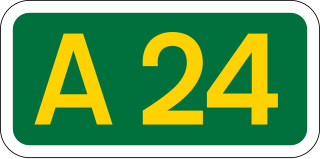
The A24 is a major road in England that runs for 53.2 miles (85.6 km) from Clapham in south-west London to Worthing on the English Channel in West Sussex via the suburbs of south-west London, as well as through the counties of Surrey and West Sussex.

The London sewer system is part of the water infrastructure serving London, England. The modern system was developed during the late 19th century, and as London has grown the system has been expanded. It is currently owned and operated by Thames Water and serves almost all of Greater London.

Stamford Brook was a tributary of the Tideway stretch of the River Thames in west London supplied by three headwaters. Historically used as an irrigation ditch or dyke, the network of small watercourses had four lower courses and mouths.
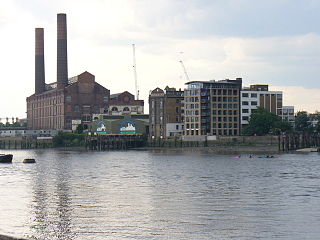
Counter's Creek, ending in Chelsea Creek, the lowest part of which still exists, was a stream that flowed from Kensal Green, by North Kensington and flowed south into the River Thames on the Tideway at Sands End, Fulham. Its remaining open watercourse is the quay of Chelsea Creek.

The Southern Outfall Sewer is a major sewer taking sewage from the southern area of central London to Crossness in south-east London. Flows from three interceptory sewers combine at a pumping station in Deptford and then run under Greenwich, Woolwich, Plumstead and across Erith marshes. The Outfall Sewer was designed by Joseph Bazalgette after an outbreak of cholera in 1853 and "The Big Stink" of 1858. Work started on the sewer in 1860 and it was finally opened on 4 April 1865 by H.R.H. the Prince of Wales.
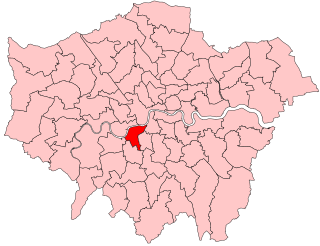
Battersea is a constituency in the London Borough of Wandsworth. It has been represented since 2017 by Marsha de Cordova of the Labour Party.
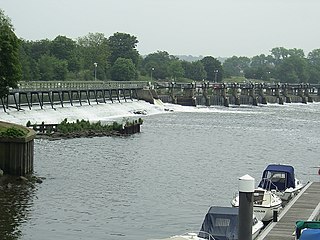
The Tideway is the part of the River Thames in England which is subject to tides. This stretch of water is downstream from Teddington Lock. The Tideway comprises the upper Thames Estuary including the Pool of London.

Balham is an interchange station located in central Balham in the London Borough of Wandsworth, South London for London Underground and National Rail services.

The inner London borough of Wandsworth contains some 670 hectares of green space in the form of parks, commons, allotments and cemeteries, which is the largest amount for an Inner London borough. Central London borders some of the borough's boundary with the Thames the closest park to which is Battersea Park.

Balham and Tooting was a constituency in South London, which returned one Member of Parliament (MP) to the House of Commons of the Parliament of the United Kingdom. It was created for the 1918 general election and abolished for the 1950 general election.
Wandsworth Central was a parliamentary constituency in the Wandsworth district of South London. It returned one Member of Parliament (MP) to the House of Commons of the Parliament of the United Kingdom, elected by the first-past-the-post voting system.
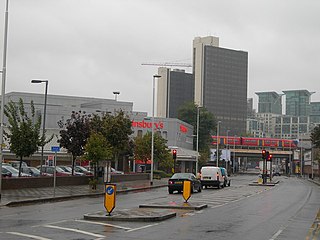
The A3036 is an A road in London, England, running from Waterloo to Wandsworth.
Wandsworth was the name of a borough constituency created in 1885, abolished in 1918, covering the vast bulk of today's London Borough of Wandsworth in South London but excluding Battersea. It returned one Member of Parliament (MP) to the House of Commons of the UK Parliament.

The Shaftesbury Park Estate, commonly known as The Shaftesbury Estate, is a residential estate in Battersea in South London, England. It lies north of Lavender Hill and Clapham Common and east of Clapham Junction railway station.
Alfred Heaver was an English carpenter turned builder and property developer, responsible for the construction of a number of housing estates amounting to thousands of homes in south London, including the Heaver Estate in Balham. He was murdered in 1901 by a relative who nursed a grudge against him.

The River Heathwall, more often known as the Heathwall Sewer, Heathwall Ditch or Heathwall Mill Pond was a set of field drainage ditches and a large mill pond in Battersea, London. It had two outlets into the tidal Thames and its inland section roughly followed Wandsworth Road. Its eastern outlet was at Nine Elms.



















